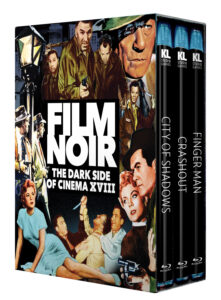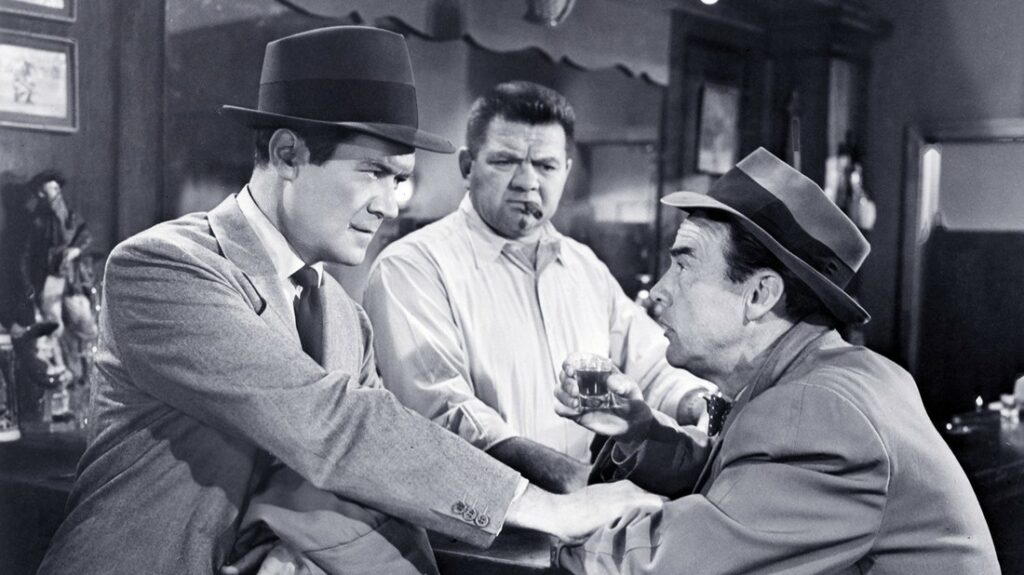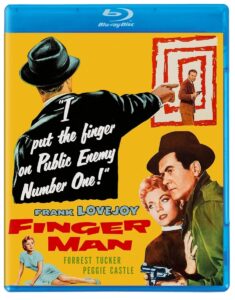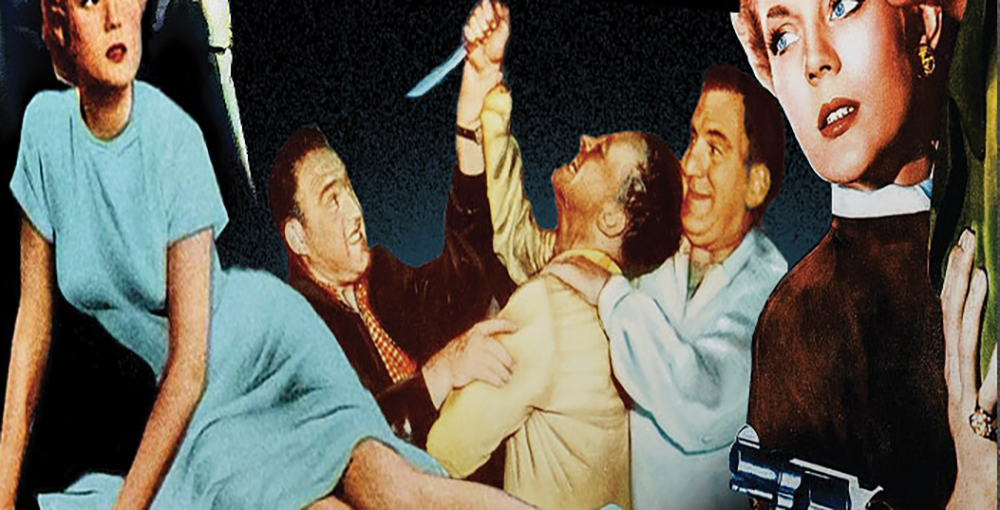City of Shadows / Crashout / Finger Man
BLU-RAY STREET DATE: MARCH 26, 2024/KL STUDIO CLASSICS

Apropos to the mixed bag that KL Studio Classics’ longrunning “The Dark Side of Cinema” series has been, its eighteenth volume is indicative of this track record. Of the requisite three films (each housed in its own individual standard Blu-ray case; the three cases collected in a handsome slipbox), two are merely passable, straining the admittedly fluid definition of “Film Noir”. But then there’s the remaining film…. we do indeed have a largely unacknowledged bit of Noir greatness on our hands. One would the size up this collection as a must-get for fans of Film Noir, crime, and (not to give away which film of the three three films it is) prison break movies. The other two ain’t bad either, albeit on their own terms.
Below, each of the three Blu-rays, each boasting a nice new HD master courtesy of Paramount Pictures, new expert commentary tracks, and optional English subtitles, are individual detailed…
City of Shadows
DIRECTED BY WILLIAM WITNEY/1955


To hear Quentin Tarantino relay stories of director William Witney, one wouldn’t be out of line in expecting a compact little Republic Pictures outing like City of Shadows to be a beginning-to-end rowdy actioner. It’s not. At most any opportunity, Tarantino is want to pontificate about the greatness of the obscure Witney. 1955’s City of Shadows demonstrates mere directorial competence; eighty-five percent a paperwork & law books movie, fifteen percent action.
Longtime John Ford stock company member Victor McLaglen stars as Big Tim Channing, a high-rolling crime boss who’s made it big with rigged slot machines “one-armed bandits”). Channing owes his great success to Dan Mason (John Baer), who as a streetwise youngster turned him onto the ways of winning. Ten years later, Channing has waited out Mason getting his law degree, specializing in criminal extradition and loopholes. It makes for of scenes of crooked businessmen in suits talking.
In the meantime, Mason falls in love with Fern Fellows (Kathleen Crowley), so now we’ve got a romance in the mix. In this development, we see McLaglen’s father figure usher the young couple to marriage and a honeymoon at a snowy ski hideaway. This makes for a fantastic and original action finale to City of Shadows even as it completely abandons cities or shadows (though neither is much of a presence throughout) in favor of a surprisingly tense shootout on a ski lift.
Film historian/screenwriter Gary Gerani affably hosts a new audio commentary, really getting into the meat and potatoes of the picture. Sharing his access to some of the film’s official documents, Gerani actively crams as much into the film’s seventy-minutes as possible. Among the blizzard of information is observations about Witney, including the detail that the ever-practical filmmaker reinvigorated movie fight scenes, shifting them from shots of entire roomfuls of flying fisticuffs to closer focus on individual guys punching other guys. It’s a fine, punchy track as Gerani does a decent job of making his rapid delivery sound neighborly.
Not much of a Film Noir at all (Gerani calls it an “anti-Noir”) but a fully watchable crime programmer, City of Shadows may be notable for its depiction of 1930s and ‘40s criminal dramas narratively shifting to Eisenhower era domesticity. Great committed performances alongside Witney’s direction elevates what would otherwise be a run-of-the-mill chatfest of characters and corruption with occasional aggression.
Crashout
DIRECTED BY LEWIS R. FOSTER/1955


In more ways than one, director Lewis R. Foster’s 1955 Crashout is the breakout film of The Dark Side of Cinema XVIII. One would go so far as to say it’s among the breakout films of The Dark Side of Cinema series, period. A masterful and challenging thriller, Crashout wields an uncompromising narrative of such staunchness, such blunt-edgedness, one could easily mistake it for a film ten years more recent than it is.
The black & white movie starts with a bang as a flood of prison inmates break out of the big house, spilling into the nearby rocky hills, dodging gunfire all the while. It’s a jarringly violent opening, replete with inmates being shot to death en masse. One lands with eyes open, stone dead. His lifeless hand is seen in closeup, covered with ants. The modest film makes use of prison footage from Riot in Cell Block 11, but it’s a valiant and natural usage.
The rest of Crashout follows the uneasy exploits of the six inmates that make it out. Ever surly and trepidatiously dependent upon one another for their survival, no love is ever lost between this band of outcasts on the run. They proceed to terrorize their way to presumed freedom, always assuming that time and distance traveled will eventually lead to home free lives. Every stop, every exchange is wrought with tense debate and, more often than not, danger- by their hands. Well intentioned policemen, travelers, revelers, a doctor, and more all pay the price.
Assuredly helmed from start to finish, it’s fairly astonishing that Crashout’s director Lewis R. Foster is as unknown as he is. Even then, he had been relegated to television, only crossing over to the big screen for curios such as the 3-D outing Those Redheads from Seattle (1953) and a run John Payne Westerns (“Payne”, not “Wayne”) including El Paso (1949) and The Eagle and the Hawk (1950). Perhaps a career reassessment is in order.
Such an effort is no doubt helped along by the disc’s new audio commentary by author/film historian Alan K. Rode. Rode begins with a surprisingly extensive history of Crashout’s perennial filming location, the Iverson Ranch, before going on to discuss the pitch-perfect grit-on-the-face storytelling of Foster and company. Much attention is paid to the perfectly cast actors, none of whom lapse into over-the-top performative hysterics or scenery chewing. Among them are William Bendix is their de facto leader whose refusal to suffer even the slightest foolishness may keep them alive but may also in a way seal their individual fates. Luther Adler plays the perpetually horny one, claiming, perhaps ridiculously, to have a girl in every town- and the single-minded drive to find them. Arthur Kennedy is the only escapee to demonstrate a real sense of morality and/or ethics, who must decide what to do when he falls hard for a forlorn girl he meets on a train (a heartbreaking Gloria Talbott).
No love is ever lost between this band of outcasts on the run, that’s for sure. They proceed to terrorize their way to presumed freedom, always assuming that time and distance traveled will eventually lead to home free lives. Every stop, every exchange is wrought with tense debate and usually danger- by their hands. Well intentioned policemen, travelers, revelers, a doctor, and more all pay the price. It’s all more than enough to earn Crashout its uncharacteristically boisterous tagline: “Bone Breaking Brutality of Killers on a Furlough from Hell!” This is one not to be missed.
Finger Man
DIRECTED BY HAROLD SCHUSTER/1951


“We’re offering you a chance to get yourself killed.” Gee thanks, officer! Granted, ex-con Casey Martin (Frank Lovejoy), finding himself collected by police detectives, is between quite the rock and hard place. Failing to have kept his nose clean, these coppers have the goods on him, and they intend to cash in.
Martin agrees. He will be their titular “finger man” in their quest to bring down crime boss Dutch Becker (Forrest Tucker). All he has to do is pursue one of the umpteen criminal leads the detectives pull down, and then when the time comes, give the guy the finger. Things get more complicated when Martin falls for Gladys (a heartbreaking Peggie Castle), formerly one of Dutch’s professional girls. As Gladys is looking to be free of her past, perhaps Martin can help her. To what degree will he also be her “finger man”? Later, with just a reassuring kiss and quick embrace, we see the central couple reconcile her implied vast background as a call girl- a rather progressive resolution for cloistered “good old 1955.” Then again, John Ford’s Stagecoach (1939) depicts a version of the same thing.
Professor and Film Scholar Jason A. Ney briefly postulates that the blacklisted Ring Lardner Jr. is the true Lardner “Story by” scribe of Finger Man, not his credited but far, far less qualified brother, John Lardner. Later, he regales us with the downright insane and ridiculous career misadventures of supporting player Timothy Carey. Ney isn’t exaggerating that Carey’s story must be heard to be believed, and even then, it might sound too nuts.
Timothy Carey’s mere presence as Dutch’s main heavy weirds things up in a satisfying way, and Castle is terrific. Lovejoy, though, makes for a detrimentally milquetoast protagonist. The screenplay has him doing hard-bitten voiceover narration throughout, a Noir trope that was pretty long-in-the-tooth by 1955. His nasal delivery has a John Mulaney-esque quality about it, making the movie sound like a spoof on the form in those moments.
As Dutch would say, “It’s good.” Good, but not great- though full of occasional quirk and interesting details. You may not always be inclined to give the woefully titled Finger Man a hand, but also you won’t want to give it the finger, man.


